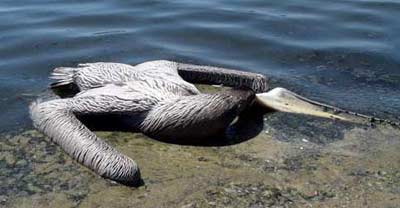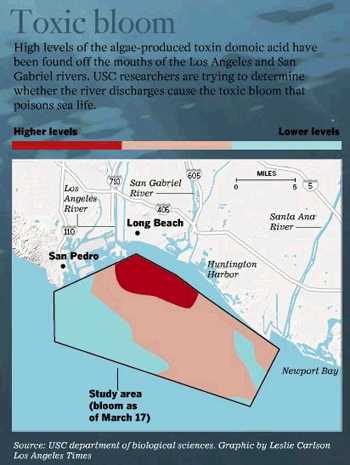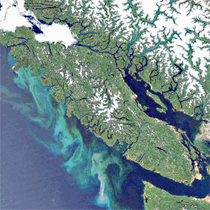
It’s happened with predictable regularity, every spring since International Bird Rescue Research Center (IBRRC) opened its center in San Pedro in 2001. The staff at the center, which specializes in seabirds, and especially California brown pelicans, calls it DA; short for Domoic Acid.
This spring is different. It’s much worse, affecting more species of birds, pinepeds and possibly even whales. Beaches are littered with dead birds, seals, dolphins, otters, and in Santa Barbara a 29 foot sperm whale washed ashore. The reasons for the deaths are not entirely certain, however, many of the animals tested were positive for domoic acid poisoning. More: Domoic Acid
Jay Holcomb, IBRRC’s director has many questions, but not enough answers. “I have been doing this work for 35 years and I have never seen anything like this as far as the number of species affected, other than an oil spill,†Holcomb said. “We have very serious concerns about what is happening to seabirds, and how it may affect populations, especially California brown pelicans, who are heading into breeding season. The loss of breeding adults at this time may impact the next generation as well,†Holcomb said. (California brown pelicans are still on the Endangered Species List, but have been petitioned for de-listing).
Pelicans with domoic acid poisoning, which affects the brain, can have seizures while flying, causing them to literally fall from the sky. Some have crashed into car windshields or ended up in places they shouldn’t be, like airport runways and freeways. Holcomb believes many seabirds having seizures out at sea drown, making it virtually impossible to count the bodies.
Although domoic acid is a naturally occurring toxin produced by microscopic algae, something is making recent blooms of the algae especially virulent. IBRRC is working closely with the Caron Laboratory at USC, providing body fluids from suspect birds for analysis. Professor Dave Caron and Assistant Research Professor Astrid Schnetzer test the waters off Southern California and alert the center when domoic acid is present. The staff then braces and prepares the ICU. The only way to save the birds is to flush the toxins out of their systems, a labor intensive process.

This spring dead birds began littering beaches in March. IBRRC rescue personnel walking the beaches reported “dead birds everywhere.†Species included grebes, gulls, cormorants, American avocets and loons. Not all test positive for DA. But other neurotoxins such as saxitoxin which can cause paralytic shellfish poisoning in humans, are also being examined by Dave Caron and Astrid Schnetzer. They are studying the birds with the help of IBRRC staff who provide fresh blood and body fluids of all sick birds. Long-time volunteer, Susan Kaveggia, orchestrates the sampling and has been instrumental in forging the relationship with USC.
The Marine Mammal Care Center, which is next door to IBRRC in Fort MacArthur, has been overwhelmed with sick seals and sea lions who eat the same fish as pelicans; anchovies and sardines. The fish eat the affected algae, which don’t kill them, but the animals that eat the fish get concentrated amounts, depending on how many affected fish they eat. Whether they live or die depends how much of the poison they ingest. Many of these sick animals have been tested by Caron and Schnetzer. More than half of those tested have been positive for DA over the past few days.
Humans have died from eating contaminated mussels. Many times people don’t know what made them sick so they don’t report it to health authorities. In humans, domoic acid poisoning can cause vomiting, nausea, diarrhea, abdominal cramps, headache, dizziness, confusion, disorientation, loss of short-term memory, motor weakness, seizures, cardiac arrhythmias, coma and possibly death. Short term memory loss is permanent, thus the name Amnesic Shellfish Poisoning. Birds and pinepeds exhibit similar symptoms. Because the toxin affects the brain, the long term effects of DA poisoning aren’t known, something that concerns Holcomb.
“In my opinion, domoic acid is the new DDT,†Holcomb said. “If the effects of DA poisoning are cumulative in the brain, and we don’t know that yet, it could have serious consequences on the population of California Brown Pelicans. As of this point, we just don’t know.â€
Global warming is thought to make algal blooms much worse by providing much better living conditions for algae. Could this massive bloom be one of many that has recently been attributed to a warming climate? This is not the first time massive algal blooms have sprung up.
Lake Washington near Seattle has had problems with massive blooms.
People can be affected, too. Climate change may be contributing to algal blooms, including a toxic variety that can trigger health warnings and beach closures. Between late spring and fall, the average temperature in the lake’s 30-foot-deep top layer has climbed by more than 2 1/2 degrees Fahrenheit compared with readings taken four decades ago. The lake’s overall average temperature has increased by 1 degree.
“It’s only 1 degree, but it has huge effects,” said UW researcher Monika Winder, who has published research on the warming trend.
Evidence of the new imbalance is mounting:
* At the bottom of the food chain, some zooplankton — barely visible organisms that devour algae and are, in turn, devoured by juvenile salmon — are declining in numbers.
* Rising temperatures are keeping the lake divided into warm and cool layers nearly a month longer than before, forcing some species of fish to seek refuge in lower depths where predators lurk.
* Salmon are swimming an ever-more tropical gantlet from the Ballard Locks to the lake. New research shows that many of the sockeye traversing the locks later in the summer aren’t surviving to spawn in the Cedar River. Last year, 200,000 sockeye — half the return — vanished before reaching the spawning grounds.
“This is going to alarm people,” said Dave Seiler, a salmon scientist with the state Department of Fish and Wildlife, “but I think the story ought to come out.”(via)

Similarly Canada saw an absolutely HUGE bloom in June of last year. So huge in fact that you could see it from space.
Scientists are worried that global warming might have contributed to creating an algae bloom off the west coast of Vancouver Island that is so big it can be seen from space.
At the Institute of Ocean Sciences in North Saanich, researchers are tracking the swirling mass that runs the length of the Island’s west coast. They believe it consists mainly of coccolithophore, a naturally occurring, single-cell phytoplankton.
It’s the biggest algae bloom institute physicist Jim Gowen has seen.
An image taken from a weather satellite shows swirling masses of a single-cell phytoplankton called coccolithophore off the west coast of Vancouver Island and Washington state. Scientists have been tracking the massive algae bloom, which is not considered harmful, since it first appeared in Barkley Sound on June 21.“The bloom is good in that it means there are lots of nutrients out there for things to grow,” he said. “But what we’re worried about is that if global warming is going to really kick in and start warming everything up, then the prediction has to be that we’ll see more of these things more often. It’s certainly worrying when you see the biggest one, because you think that it’s a sign things are getting worse.”(via)
This last Saturday, Nov. 24, 2007, several of us on the Hermosa Beach pier noticed what we would term a very strange flight of Brown Pelicans flying north by the thousands.
My friend and i were having an early dinner at a restaurant when we noticed a unusually long line of Brown pelicans flying north. We finished dinner and went to the pier and they kept flying that way until dark. Others on pier also commneted on the strange flight.
I was wondering if you have ever seen this at this time of the year and might comment on what it might mean. I was with people who have lived there for 20 to 30 years and have never seen such a flight before.
Aimee: That is crazy, I have no idea why they would be flying north this time of year, or what would cause thousands of them to gather like that. But it does sound like an interesting sight. Did you get any pictures?
if this is ok china they should pick up and help things in the inviroment